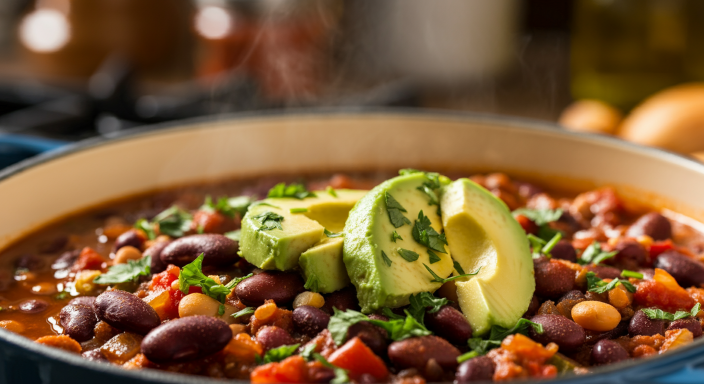The Ultimate Guide to Vegetarian Bean Recipes: Healthy, Hearty, and Delicious
Vegetarian bean recipes are not just a staple for those following a plant-based diet; they are transformative meals that can elevate any dining experience. Packed with protein, fiber, and essential nutrients, beans are versatile ingredients that can be used in a variety of dishes. In this article, we will explore delicious vegetarian bean recipes, their health benefits, and practical tips for incorporating them into your meals. Whether you are a seasoned vegetarian or just looking to add more plant-based options to your diet, this guide will provide you with everything you need to know about cooking with beans.
Beans are often overlooked in the culinary world, yet they offer a wealth of flavors and textures that can enhance any dish. From hearty stews to refreshing salads, beans can be the star of the show or a complementary ingredient. Their ability to absorb flavors makes them a favorite in cuisines around the globe. As we delve into the world of vegetarian bean recipes, you will discover not only how to prepare these nutritious legumes but also how to make them a delightful part of your everyday meals.
Key Aspects of Vegetarian Bean Recipes
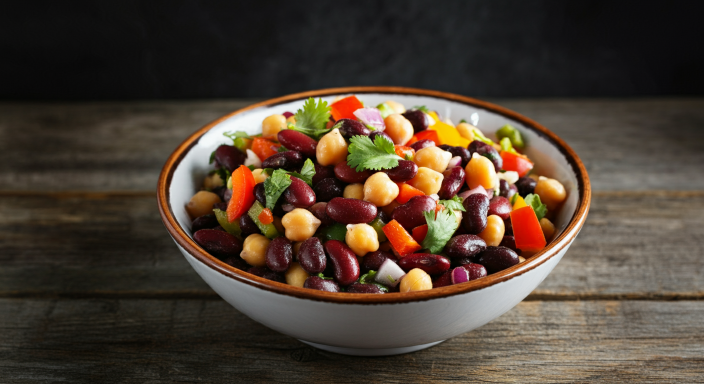
Beans are among the most nutritious foods available. According to the USDA, a cup of cooked beans provides around 15 grams of protein and 13 grams of fiber, making them an excellent choice for vegetarians and meat-eaters alike. Studies show that incorporating legumes into your diet can help reduce the risk of chronic diseases, promote digestive health, and contribute to weight management.
- Nutritional Profile: Beans are rich in essential nutrients such as iron, magnesium, potassium, and folate. They are low in fat and high in fiber, which can help regulate blood sugar levels and support heart health. The high fiber content also aids in digestion, promoting a healthy gut.
- Variety of Types: There are numerous types of beans available, each with its unique flavor and texture. Common varieties include black beans, kidney beans, pinto beans, chickpeas, and lentils. This variety allows for endless possibilities in the kitchen, from hearty stews to refreshing salads.
- Sustainability: Beans are also an environmentally friendly food choice. They require less water and land to produce compared to animal proteins, making them a sustainable option for those looking to reduce their environmental footprint. Incorporating more plant-based meals into your diet is a simple yet effective way to contribute to a healthier planet.
- Affordability: Beans are one of the most economical protein sources available. Dried beans are particularly cost-effective, and even canned beans are relatively inexpensive. This makes them an excellent choice for budget-conscious individuals and families. A can of beans can often be purchased for less than a dollar, making them a staple in many households.
- Culinary Versatility: Beans can be used in a wide range of dishes, from soups and stews to salads and dips. They can be the star of the meal or serve as a hearty addition to other recipes. The ability to blend beans into various cuisines—from Mexican to Mediterranean—makes them a valuable ingredient in any kitchen.
Ingredients List
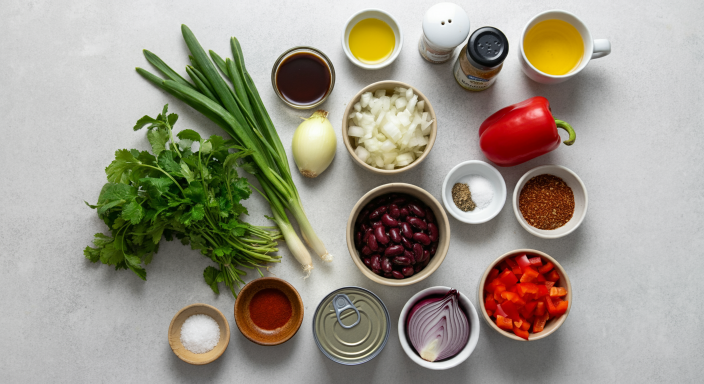
When preparing vegetarian bean recipes, having a clear and simple ingredients list is essential. Here’s a basic list to get you started:
- 1 cup dried beans (e.g., black beans, kidney beans, chickpeas)
- 1 medium onion, diced
- 2 cloves garlic, minced
- 1 bell pepper, chopped (any color)
- 1 can diced tomatoes (14 oz)
- 1 teaspoon cumin
- 1 teaspoon chili powder
- Salt and pepper to taste
- Fresh cilantro for garnish
- Olive oil for sautéing
This basic list can be modified based on your preferences and the specific recipe you choose to follow. Feel free to add other vegetables, spices, or herbs to enhance the flavor and nutritional value of your dishes.
Step-by-Step Instructions
Here’s a simple step-by-step guide for a delicious vegetarian bean dish that anyone can make, even beginners:
- Soak the Beans: Rinse the dried beans under cold water and soak them overnight in a large bowl of water. This helps to soften the beans and reduces cooking time. If you’re short on time, you can use the quick soak method by boiling the beans for 2 minutes and then letting them sit for 1 hour.
- Cook the Beans: After soaking, drain and rinse the beans again. In a large pot, add the soaked beans and cover them with fresh water. Bring to a boil, then reduce the heat and let them simmer until tender, which can take anywhere from 1 to 2 hours depending on the type of bean. Alternatively, you can use a pressure cooker to speed up the process.
- Sauté the Vegetables: In a separate pan, heat a tablespoon of olive oil over medium heat. Add the diced onions and minced garlic, sautéing until the onions are translucent and fragrant. This step adds a depth of flavor to your dish.
- Combine Ingredients: Add the chopped bell pepper to the sautéed onions and garlic, cooking for an additional 3-4 minutes until the pepper softens. Then, stir in the cooked beans, diced tomatoes, cumin, chili powder, salt, and pepper. Mix well and let the mixture simmer for about 20 minutes, allowing the flavors to meld together.
- Serve: Once everything is heated through and well combined, remove the pot from heat. Garnish with fresh cilantro before serving. This dish pairs beautifully with rice, tortillas, or can be enjoyed on its own.
Nutritional Value
Here’s a breakdown of the nutritional benefits of the key ingredients in this vegetarian bean recipe:
| Ingredient | Nutritional Benefits |
|---|---|
| Beans | High in protein and fiber; supports heart health and digestion. |
| Onion | Contains antioxidants; may help reduce inflammation. |
| Garlic | Boosts immune function; has anti-inflammatory properties. |
| Bell Pepper | Rich in vitamins A and C; supports eye health and immune function. |
| Tomatoes | High in lycopene; promotes skin health and may reduce cancer risk. |
| Cilantro | Contains antioxidants; may help detoxify the body. |
Incorporating these ingredients into your diet not only enhances the flavor of your meals but also contributes to overall health and well-being.
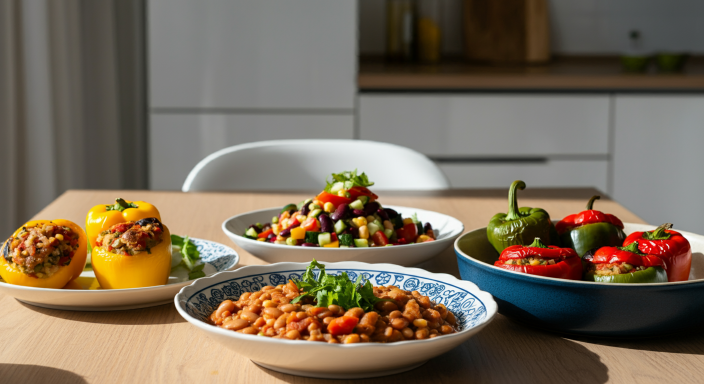
Benefits of Vegetarian Bean Recipes
The benefits of vegetarian bean recipes extend beyond just nutrition. Here are some compelling reasons to include them in your diet:
- Versatility: Beans can be used in a wide range of dishes, from soups and stews to salads and dips. They can be the star of the meal or serve as a hearty addition to other recipes.
- Satiety: The high fiber and protein content in beans promote a feeling of fullness, which can help prevent overeating and aid in weight management. This makes them an excellent choice for those looking to maintain or lose weight.
- Heart Health: Regular consumption of beans has been linked to lower cholesterol levels and improved heart health. The soluble fiber in beans can help reduce LDL (bad) cholesterol, while their nutrient profile supports overall cardiovascular health.
- Blood Sugar Control: The complex carbohydrates in beans are digested slowly, leading to a gradual release of glucose into the bloodstream. This helps stabilize blood sugar levels and can be particularly beneficial for individuals with diabetes.
- Culinary Adventure: Experimenting with different types of beans and flavors can make cooking exciting. From spicy black bean tacos to creamy white bean hummus, the possibilities are endless.
- Plant-Based Protein: For those looking to reduce meat consumption, beans provide an excellent source of plant-based protein. They can easily replace meat in many recipes, offering a satisfying and nutritious alternative.
- Digestive Health: The fiber in beans is beneficial for digestive health. It helps regulate bowel movements and can prevent constipation, contributing to a healthier gut.
- Cost-Effectiveness: Beans are an economical source of nutrition. They can stretch a meal further and are often more affordable than meat, making them a smart choice for families on a budget.
Overcoming Challenges
While cooking with beans is rewarding, it can also come with challenges. Here are some common issues and practical tips to address them:
- Cooking Time: Dried beans can take a long time to cook, which may deter some people. To save time, consider using canned beans, which are already cooked and can be added directly to dishes. Just be sure to rinse them thoroughly to reduce sodium content.
- Texture: Some people may find the texture of beans unappealing. To overcome this, blend cooked beans into soups or dips for a creamy consistency. Alternatively, mash them for bean burgers or fritters.
- Flavor: Beans can sometimes lack flavor on their own. To enhance their taste, use a variety of spices and herbs, and cook them with aromatic ingredients like onions and garlic. Don’t be afraid to experiment with different flavor profiles!
- Digestive Issues: Some individuals may experience digestive discomfort after consuming beans. To minimize this, gradually increase your intake of beans to allow your digestive system to adjust. Soaking beans before cooking can also help reduce gas-producing compounds.
- Ingredient Availability: Depending on your location, some types of beans may not be readily available. In such cases, feel free to substitute with other varieties or use dried beans instead of canned ones, which can often be found in bulk.
- Meal Planning: Planning meals around beans can be challenging if you’re not used to cooking with them. Start by incorporating one or two bean-based meals into your weekly rotation, and gradually increase as you become more comfortable.
Future Trends
As plant-based diets gain popularity, the demand for innovative vegetarian bean recipes is expected to rise. Here are some trends that are shaping the future of bean-based cooking:
- Convenience Products: The market for convenient, ready-to-eat bean products is expanding. Look for options like bean-based pasta, snacks, and frozen meals that make it easier to incorporate beans into your diet.
- Fusion Cuisine: Chefs are increasingly blending traditional bean recipes with global flavors, creating exciting new dishes. For example, Indian-inspired black bean curry or Mediterranean chickpea salad are gaining popularity.
- Health and Wellness: As more consumers prioritize health, there is a growing interest in high-protein, plant-based foods. Beans are at the forefront of this trend, offering a nutritious alternative to animal proteins.
- Sustainable Eating: With a focus on sustainability, more people are seeking plant-based options that have a lower environmental impact. Beans are a great choice, as they require fewer resources to produce compared to meat.
- Innovative Recipes: As culinary creativity flourishes, expect to see more innovative recipes featuring beans. From desserts made with black beans to bean-based smoothies, the possibilities are expanding.
- Educational Resources: As interest in plant-based eating grows, so does the availability of educational resources. Cookbooks, online courses, and cooking classes focused on beans and legumes are becoming more common, helping people learn how to cook with these nutritious ingredients.
Tips and Tricks Section
Here are some helpful tips and tricks to enhance your experience with vegetarian bean recipes:
- Flavor Enhancements: Don’t be afraid to experiment with different spices and herbs. Adding a splash of lime juice or a dash of hot sauce can elevate the flavor of your dish.
- Storage: Cooked beans can be stored in the refrigerator for up to a week or frozen for longer shelf life. Portion them out into containers for easy meal prep.
- Batch Cooking: Consider cooking a large batch of beans at once and using them throughout the week in various recipes. This saves time and ensures you always have a healthy protein source on hand.
- Pairing Ideas: Beans pair well with a variety of ingredients. Try serving them with whole grains like quinoa or brown rice, and incorporate plenty of colorful vegetables for a balanced meal.
- Presentation: Make your dishes visually appealing by garnishing with fresh herbs, avocado slices, or a drizzle of olive oil. A beautiful presentation can enhance the dining experience.
- Experiment with Textures: Incorporate different textures into your dishes by combining whole beans with pureed beans. This adds variety and interest to your meals.
- Use Leftovers Creatively: Leftover bean dishes can be transformed into new meals. For example, use leftover bean chili as a filling for burritos or enchiladas.
- Make Your Own Bean Dip: Blend cooked beans with garlic, lemon juice, and tahini for a delicious dip. This can be served with veggies or pita chips for a healthy snack.
Variations and Adaptations
One of the great things about vegetarian bean recipes is their adaptability. Here are some suggestions for diet-friendly variations:
- Gluten-Free: Substitute regular pasta with gluten-free pasta or serve your bean dishes with quinoa or rice for a gluten-free option.
- Spicy Version: If you enjoy heat, add jalapeños or cayenne pepper to your recipes for a spicy twist. You can also incorporate spicy sauces or salsas for added flavor.
- Protein Boost: For those looking to increase protein intake, consider adding other protein sources such as tofu, tempeh, or seitan to your bean dishes.
- Low-Carb: For a low-carb option, use beans in moderation and focus on pairing them with non-starchy vegetables. Zucchini noodles or cauliflower rice can be great substitutes for traditional grains.
- Kid-Friendly: To make bean dishes more appealing to kids, try incorporating familiar flavors and textures. For example, create bean burgers or tacos with their favorite toppings.
- Seasonal Variations: Adapt your bean recipes to include seasonal vegetables. In the summer, add fresh corn and zucchini; in the fall, incorporate butternut squash or sweet potatoes.
- Cultural Influences: Explore global cuisines by incorporating beans into traditional dishes. For instance, use black beans in a Cuban black bean soup or chickpeas in a Moroccan tagine.
- Creative Salads: Use cooked beans as a base for salads. Combine them with fresh greens, roasted vegetables, and a tangy vinaigrette for a satisfying meal.
FAQs Section
Here are some common questions about vegetarian bean recipes:
- Can I use canned beans instead of dried? Yes, canned beans are a convenient alternative. Just be sure to rinse them before use to remove excess sodium.
- How do I store leftover bean recipes? Store leftovers in an airtight container in the refrigerator for up to 5 days. You can also freeze them for longer storage.
- What are some good bean substitutes? If you’re looking for alternatives to beans, consider using lentils, peas, or chickpeas. Each has its unique flavor and texture.
- How can I make my bean dishes more flavorful? Experiment with different spices, herbs, and aromatics. Adding ingredients like smoked paprika, cumin, or fresh herbs can significantly enhance the flavor.
- What are some quick bean recipes for busy weeknights? Some quick options include bean salads, bean tacos, or bean soups that can be made in under 30 minutes.
- How can I incorporate beans into breakfast? Beans can be a delicious addition to breakfast. Try adding black beans to scrambled eggs or making a breakfast burrito with beans and avocado.
- Are beans suitable for meal prep? Absolutely! Cooked beans store well and can be used in various dishes throughout the week, making them perfect for meal prep.
- Can I freeze cooked beans? Yes, cooked beans freeze well. Portion them into containers and freeze for later use in soups, stews, or salads.
Conclusion
Vegetarian bean recipes offer a delicious and nutritious way to enjoy meals while supporting a healthy lifestyle. With their versatility and health benefits, beans are truly a powerhouse ingredient. By incorporating these recipes into your weekly meal plan, you can enjoy a variety of flavors and textures while reaping the numerous health benefits that beans provide.
As you explore the world of vegetarian bean recipes, remember that the possibilities are endless. Don’t hesitate to experiment with different flavors, cuisines, and cooking methods. Whether you’re making a comforting bean chili, a refreshing bean salad, or a hearty bean stew, each dish can be a delightful culinary adventure.
Incorporating beans into your diet not only enhances your meals but also contributes to a healthier planet. By choosing plant-based ingredients, you’re making a positive impact on the environment and embracing a sustainable lifestyle.
Don’t forget to share your experiences and favorite recipes in the comments below, and feel free to subscribe for more plant-based cooking inspiration! Together, let’s celebrate the joy of cooking with beans and discover the transformative power of vegetarian recipes
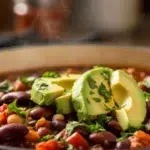
Vegetarian Bean Dish
Ingredients
Dried Beans
- 1 cup dried beans (e.g., black beans, kidney beans, chickpeas) Soaked overnight or quick-soak method.
Vegetables
- 1 medium onion, diced
- 2 cloves garlic, minced
- 1 medium bell pepper, chopped (any color)
- 1 can (14 oz) diced tomatoes
Spices
- 1 teaspoon cumin
- 1 teaspoon chili powder
- to taste salt and pepper
Other
- 1 tablespoon olive oil for sautéing
- to taste fresh cilantro for garnish
Instructions
Preparation
- Soak the beans by rinsing and soaking them overnight in water or using the quick soak method by boiling for 2 minutes and letting sit for 1 hour.
- Drain and rinse the soaked beans again.
Cooking
- In a large pot, add the soaked beans and cover them with fresh water. Bring to a boil, then reduce the heat and simmer until tender, about 1 to 2 hours.
- In a separate pan, heat olive oil and sauté the diced onions and minced garlic until the onions are translucent.
- Add the chopped bell pepper to the sautéed onions and garlic, cooking for additional 3-4 minutes.
- Stir in the cooked beans, diced tomatoes, cumin, chili powder, salt, and pepper. Mix well.
- Let the mixture simmer for about 20 minutes to allow the flavors to meld.
- Garnish with fresh cilantro before serving.

